 A coalition of government policy makers, technology and broadband companies from China have rocked up to the NAB2005 Media Show in Las Vegas.
A coalition of government policy makers, technology and broadband companies from China have rocked up to the NAB2005 Media Show in Las Vegas.
They’re in town to invite opportunity-seeking US companies to supply programming and interactive content to the Chinese coalition-backed IDV Global Media On-Demand platform, expected to launch in China early next year.
Developed by California-based IDV, the platform was a top-secret project until premiered at the China Media-on-Demand Coalition press conference last week in Beijing, and reflects China’s eagerness to create new technologies for the Internet and telecom.
IDV-Global Media – headed by ex-Microsoft’s Xbox game console designer, Kevin Bachus – expects the new technology to allow Chinese media companies to securely distribute programs worldwide, direct from publisher to consumer.
Bachus rose to media attention when he left Microsoft to start a rival games console business, Infinium Labs. Their product, the Phantom Game Service, downloaded game content directly over an Internet connection. Digital-Lifestyles has been covering the Phantom since the start of 2004, from its first demo, through the announcement of its launch, to them receiving a $50 million credit investment.
Some of the press had speculate that Bachus had left Infinium. At the start of this week he issued a statement denying that he had left Infinium for IDV Global Media.
Duncan Clark, managing director of the Beijing-based consulting firm BDA China Ltd., warned that IDV-Global Media will need support from a range of participants, including telecoms, media and electronics companies (and the government agencies that regulate them) for the project to work.
“What this initiative claims to attain, aligning the interests of many different players in the value chain, is something that has eluded many a media mogul outside China,” Clark sagely added.
IDV GMOD’s platform is an end-to-end solution that includes a second generation PC with a 3D “platform-on-platform” architecture developed by IDV – the first system to receive certification from China as the standard for second generation PCs.
Content will be delivered to consumers by digital feeds from global sources, including a next generation Internet, based on the IPv6 technology, with revenue sharing arrangements for partners.
This system will supply sports events, movies, TV shows, next gen games and other interactive entertainment direct to private residences or hotel rooms worldwide, with the same interface, in High Definition (HD) quality video.
The wonderfully named Dr Fan Yeqiang, deputy director of the China Institute of Policy Studies (CIPS), said in a statement, “Now US media publishers and distributors have a direct platform on which to earn millions of dollars in incremental revenues from their content in the China market. We are offering a safe, certified delivery system never available to US media companies before.”
 Motorola handset owners will now be able to go multiplayer bonkers, courtesy of a new selection of real-time, multiplayer games from Motorola’s consumer portal, www.hellomoto.com.
Motorola handset owners will now be able to go multiplayer bonkers, courtesy of a new selection of real-time, multiplayer games from Motorola’s consumer portal, www.hellomoto.com. As well as playing directly against other phone users, game-hungry portal visitors will also be able to compete in ladder tournaments, view global rankings and chat in-game.
As well as playing directly against other phone users, game-hungry portal visitors will also be able to compete in ladder tournaments, view global rankings and chat in-game. “This represents another major step forward in the development of Terraplay given the stature of Motorola in the global wireless market. Motorola’s initiative is excellent news for the growth of the multiplayer sector,” purred Jeremy Lewis, Chairman of the Advisory Board, Terraplay Systems, “Multiplayer gaming, offered as premium services, is a real revenue generator and an ideal path to higher ARPU for all service providers”.
“This represents another major step forward in the development of Terraplay given the stature of Motorola in the global wireless market. Motorola’s initiative is excellent news for the growth of the multiplayer sector,” purred Jeremy Lewis, Chairman of the Advisory Board, Terraplay Systems, “Multiplayer gaming, offered as premium services, is a real revenue generator and an ideal path to higher ARPU for all service providers”. The Electoral Commission is supporting efforts to get the UK’s young voters well up for the forthcoming election by encouraging them to get down wiv their mobiles.
The Electoral Commission is supporting efforts to get the UK’s young voters well up for the forthcoming election by encouraging them to get down wiv their mobiles. Becky Lloyd, campaigns manager at the Electoral Commission rapped: “It’s important that we communicate with the younger electorate in particular through a medium with which they are comfortable and familiar and mobile phones are a good way of doing this.”
Becky Lloyd, campaigns manager at the Electoral Commission rapped: “It’s important that we communicate with the younger electorate in particular through a medium with which they are comfortable and familiar and mobile phones are a good way of doing this.”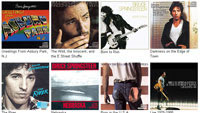 US Record industry honchos will be taking a bigger interest than unusual in the new Springsteen release as they wait to see how the new DualDisc format goes down with Brooooooce fans.
US Record industry honchos will be taking a bigger interest than unusual in the new Springsteen release as they wait to see how the new DualDisc format goes down with Brooooooce fans.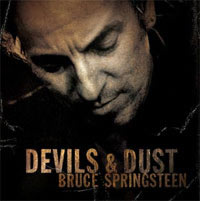 The music business is hoping that the new format – and the extra cash – will help recoup the slice of the retail market lost to piracy and illegal file-sharing. “It’s harder to file-share DVD content and it’s virtually impossible for anyone to burn a DualDisc at home,” purred Thomas Hesse, president of global digital business for Sony BMG.
The music business is hoping that the new format – and the extra cash – will help recoup the slice of the retail market lost to piracy and illegal file-sharing. “It’s harder to file-share DVD content and it’s virtually impossible for anyone to burn a DualDisc at home,” purred Thomas Hesse, president of global digital business for Sony BMG.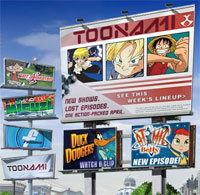 Video Networks Limited (VNL), who operate the HomeChoice VOD service around London, have added the children’s animation channel Toonami to their line up using the MPEG-4 / AVC format, making it the world’s first television channel to be encoded with advanced compression technology.
Video Networks Limited (VNL), who operate the HomeChoice VOD service around London, have added the children’s animation channel Toonami to their line up using the MPEG-4 / AVC format, making it the world’s first television channel to be encoded with advanced compression technology. VNL’s migration to MPEG-4 for its remaining broadcast channels, including the Cartoon Network and Boomerang, is expected to be completed within the next two months. In time the VOD service will also be moved to the new CoDec.
VNL’s migration to MPEG-4 for its remaining broadcast channels, including the Cartoon Network and Boomerang, is expected to be completed within the next two months. In time the VOD service will also be moved to the new CoDec. “The first commercially available encoding platform to support MPEG-2, MPEG-4/AVC and SMPTE VC-1, Harmonic’s DiviCom MV 100 enabled VNL to provision a compelling video-over-DSL service while in parallel developing the elements of an MPEG-4 environment.
“The first commercially available encoding platform to support MPEG-2, MPEG-4/AVC and SMPTE VC-1, Harmonic’s DiviCom MV 100 enabled VNL to provision a compelling video-over-DSL service while in parallel developing the elements of an MPEG-4 environment. A government-backed study has revealed that more than one in 10 UK teenagers frequently use the Internet to look at “adult-only” Web sites.
A government-backed study has revealed that more than one in 10 UK teenagers frequently use the Internet to look at “adult-only” Web sites. When it came to trusting the media, television was seen as the most trustworthy form of mass communication, with 48% trusting it completely or a lot.
When it came to trusting the media, television was seen as the most trustworthy form of mass communication, with 48% trusting it completely or a lot.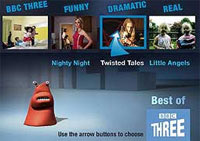 BBC Three viewers will be able to schedule their own Sunday night viewing in a pioneering multi-screen application trial starting on 1 May 2005.
BBC Three viewers will be able to schedule their own Sunday night viewing in a pioneering multi-screen application trial starting on 1 May 2005. Emma Somerville, the BBC’s Head of Interactive Programming, added: “Interactive TV can really help our audiences engage with the BBC’s TV channels.”
Emma Somerville, the BBC’s Head of Interactive Programming, added: “Interactive TV can really help our audiences engage with the BBC’s TV channels.” Old school TV listings magazine The Radio Times, has announced a partnership with Gemstar, the Murdoch-owned electronic programme guide (EPG).
Old school TV listings magazine The Radio Times, has announced a partnership with Gemstar, the Murdoch-owned electronic programme guide (EPG). This partnership kicks the Radio Times firmly into the new digital age of television, with the company selling advertising on Guide Plus+ and boosting awareness of the EPG by plugging it relentlessly in its print magazine.
This partnership kicks the Radio Times firmly into the new digital age of television, with the company selling advertising on Guide Plus+ and boosting awareness of the EPG by plugging it relentlessly in its print magazine. Gill Hudson, editor of the Radio Times, declared: “There is now no format not covered by Radio Times – you can access RT via mobile, your PDA, online, and now the Guide Plus+ EPG.”
Gill Hudson, editor of the Radio Times, declared: “There is now no format not covered by Radio Times – you can access RT via mobile, your PDA, online, and now the Guide Plus+ EPG.” Worldwide shipments of PCs rose by 10.3 percent in the first quarter, with global shipments increasing to 50.4 million units, up from the 45.7 million PCs shifted during the same period a year ago.
Worldwide shipments of PCs rose by 10.3 percent in the first quarter, with global shipments increasing to 50.4 million units, up from the 45.7 million PCs shifted during the same period a year ago. The report notes that lower vendor prices and the strong Euro to the dollar exchange rate helped open up small business wallets over Europe.
The report notes that lower vendor prices and the strong Euro to the dollar exchange rate helped open up small business wallets over Europe.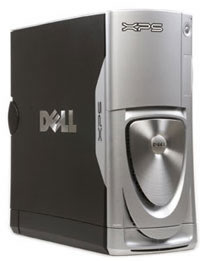 In the US market – the biggest in the world – Apple shimmied up to fifth position, elbowing Toshiba down a place.
In the US market – the biggest in the world – Apple shimmied up to fifth position, elbowing Toshiba down a place. Last week, 250 executives from advertising agencies, game developers and publishers swarmed into the first annual Advertising in Games Forum on 14 April 2005 in New York City.
Last week, 250 executives from advertising agencies, game developers and publishers swarmed into the first annual Advertising in Games Forum on 14 April 2005 in New York City. For the benefit of buzzword-deficient execs, Yankee Group senior analyst Mike Goodman explained that this hideous word describes what you get when advertisers create a game around a product rather than place their brands within a well-known title.
For the benefit of buzzword-deficient execs, Yankee Group senior analyst Mike Goodman explained that this hideous word describes what you get when advertisers create a game around a product rather than place their brands within a well-known title. Fact-bloated attendees also learned that the top selling 2004 game titles (according to the NPD Group) were:
Fact-bloated attendees also learned that the top selling 2004 game titles (according to the NPD Group) were: